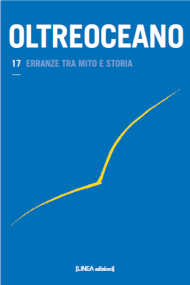El concepto de negación en La culpa es de los tlaxcaltecas de Elena Garro
DOI:
https://doi.org/10.53154/Oltreoceano10Keywords:
negación, morfosintaxis, semántica, memoria histórica y mítica, identidad mexicanaAbstract
Nuestro objetivo es el de analizar cómo los elementos de la negación, una categoría morfosintáctica, acaban configurándose como elementos de significación léxico-semántica en un relato sobre la dualidad temporal que está en la base de la identidad del ser mexicano.
Il concetto de negazione in La culpa es de los tlaxcaltecas di Elena Garro
Il nostro obiettivo è analizzare come i vari elementi della negazione, una categoria morfosintattica, finiscano per configurarsi come elementi di significato lessicale-semantico in un racconto sulla dualità temporale che sta alla base dell’identità dell’essere messicano.
The concept of negation in La culpa es de los tlaxcaltecas by Elena Garro
Our objective is to analyse how the various elements of negation, a morphosyntactic category, end up configuring themselves as elements of lexical-semantic significance in a story about the Mexican temporal duality that is at the base of the identity of the Mexican being.
Downloads
References
Bauman, Z. (2007): Tiempos líquidos. Barcelona: Tusquets.
Benavente, L. R. (2008): Historia narrativa de la conquista de los indígenas mexicanos: Elena Garro. En P. Rosas Lopategui (Ed.), Yo quiero que haya mundo… Elena Garro. 50 años de dramaturgia (pp.385-393). México D. F.: Porrúa & BUAP.
Bernini, G. & Ramat, P. (1992): La frase negativa nelle lingue d’Europa. Bologna: Il Mulino.
Cascón Martín, E. (1995): Español coloquial. Madrid: Edinumen.
Colegio de México (2018): Diccionario del Español de México (DEM). Recuperado de http://dem.colmex.mx
Eliade, M. (1991): Mito y realidad. Barcelona: Labor.
Eliade, M. (2001): El mito del eterno retorno. Buenos Aires: Emecé.
Garro, E. (1958): Un hogar sólido y otras piezas en un acto. Xalapa: Universidad Veracruzana.
Garro, E. (1963): Los recuerdos del porvenir. México D. F.: Joaquín Mortiz.
Garro, E. (1979): Felipe Ángeles. México D. F.: Universidad Nacional Autónoma de México.
Garro, E. (2006): La semana de colores. México D. F.: Porrúa.
Lamíquiz Ibáñez, V (1987): Lengua española. Métodos y estructuras lingüísticas. Barcelona: Ariel.
Luque, R., (2009): La culpa es de los tlaxcaltecas: el lenguaje como puente temporal en Elena Garro. Il bianco e il nero, 11, pp. 181-191.
Manteca Alonso-Cortés, A. (1981): La gramática del subjuntivo. Madrid: Cátedra.
Paz, O. (2002): El laberinto de la soledad. En O Paz, Obras Completas, V. Barcelona: Galaxia Gutemberg.
Ramat, P. (1987): Linguistic Tipology. New York / Amsterdam: Mouton de Gruyter.
Real Academia Española (Ed.) (2009): Nueva Gramática de la Lengua Española (NGLE), II. Madrid: Asociación de Academias de la Lengua Española / Espasa.
Real Academia Española (2014): Diccionario de la Lengua Española (DLE). Recuperado de www.rae.es
Sanz Alonso, B. (1995): La negación en español. En M. Rueda Rueda, E. Prado Iban, J. Le Men Loyer & F. Javier Grande Alija (Eds.): Actas del VI Congreso de ASELE (pp. 379-384). León: Universidad de León.
Stickel, G. (1975): Einige syntaktische und pragmatische Aspekte der Negation. En H. Weinrich (Ed.), Positionen der Negativitat (pp.17-38). Munchen: Fink.
Downloads
Published
How to Cite
Issue
Section
License

This work is licensed under a Creative Commons Attribution-NonCommercial-ShareAlike 4.0 International License.
The authors undertake to comply with the following conditions, which are considered accepted at the time of submission of their contributions.
The sending of a text implies that it is unpublished and not submitted to be published elsewhere.
1. If accepted, the author shall confer on the publisher the right to publish and distribute it both in paper form and in the online electronic edition. The published articles will be downloadable and made available in open access.
2. Provided that it correctly indicates that the first publication took place in the journal Oltreoceano. Rivista sulle migrazioni the author has the right to: a) reproduce the article in separate extracts or collected in a volume; b) publish the article on their personal website or teaching site provided that these sites are of a non-commercial nature; c) deposit the article in online archives of a non-commercial nature, linked to the institution they belong to or as part of projects for the non-commercial dissemination and open access of scientific works.
The use of contributions by third parties, for commercial or otherwise unauthorized purposes, is not allowed. The publisher declines all responsibility for the unauthorized use of the material published in the journal.












